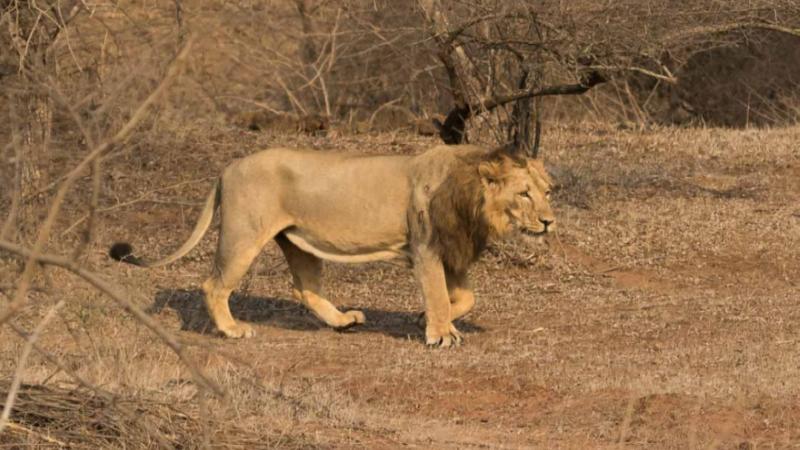
Study traces the evolution of extinct and living lions through genes and provides hints for conservation.
Disney’s 1994 animated film, The Lion King, immortalised the character Simba, a young lion cub, and intrigued many into the lives of lions—majestic cats now restricted to only parts of Africa and India. It may be a surprise to learn that, not long ago, they were found all over the world! About fifteen thousand years ago, the cave lions of Eurasia, the American lions of North America, the Barbary lions of North Africa, the Cape lions of South Africa, along with today’s lions, roamed the planet. Their extinction started with the cave lions about 14,000 years ago. In the last 150 years, humans have wiped off the Barbary lions and the Cape lions, hunting them to extinction.
Today, a curious question in science is to know how these different types of lions evolved and how different are today’s lions from their ancestors. In a new study, an international team of researchers have tried to answer these questions by analysing the genes of extinct and living lions. The study, published in the Proceedings of the National Academy of Sciences (PNAS), finds that about 500,000 years ago, modern and now-extinct lions shared a common ancestor. Further, about 70,000 years ago, two different lineages of modern lions emerged. The findings also have implications on the conservation of the remaining lion population, which is just 10% of what it was a century ago.
“Lions are absolutely a keystone species, and the health of lions generally reflects the health of the total ecosystem,” says Dr Ross Barnett from the University of Copenhagen, Denmark. An author of the present study, he has worked on cat genetics for years. “Studying lions gives us an excellent ‘big picture’ of general trends,” he adds.
Most previous studies on understanding the evolution of lions used mitochondrial DNA that is present in the mitochondria of the cell and has limited information. In the current study, the researchers have used the complete DNA sequence, extracted from 30,000-year-old fossil samples, century-old samples and live individuals. These included the cave lions (Panthera leo spelaea), and modern lions (Panthera leo leo) found in Africa and India.
“We looked at it from the whole genome angle. This allows us to get not only a robust answer on how the different populations of lions relate but also study the diversity in the remaining populations,” says Dr Thomas Gilbert. He is a professor at the University of Copenhagen and a co-author of the study. “The new results illustrate the power of the genomics in revealing lost secrets of prehistory by reading the DNA footprints of ancient and modern species,” says another co-author Dr Stephen J. O’Brien from Nova Southeastern University, USA.
The study found that until about half a million years ago, the cave lions, which lived in cold regions, and the modern lions, shared a common ancestor. This finding is consistent with other fossil evidence. Any evidence of a hybrid between cave lions and modern lions seemed to be absent. The modern lions split up into two distinct north and south lineages about 70,000 years ago, with Africa being a ‘melting pot’ of these ancestries. The northern lineage, found north of the Sahara, includes lion populations from North Africa and West Africa. In contrast, the southern lineage includes sub-Saharan lions found in Central, East and South Africa.
Indian Lions: Genetically least diverse
Among the samples studied by the researchers were Asiatic lions from the Gir forests, the only home for wild Asiatic lions. The study, although traced the origins of Asiatic lions to the northern lineage, found that they shared a fifth of their genetic structure with the southern lineage. However, it found no evidence that these lions were recently introduced from outside India. But one of the most alarming findings of the study was how less the genetic diversity was among the Asiatic lions.

A family of Asiatic Lions in Gir [Image Credits: By Shubhammahla19 - Own work, CC BY-SA 4.0]
“They are well known to be very inbred as the population is tiny,” says Dr Gilbert. Their analysis found that the two samples of Indian lions were almost identical, with inbreeding as a result of dwindling numbers since the 18th century. By the 20th century, only twenty lions remained in the Kathiawar Peninsula in Gujarat. “The risks are that there could be both an elevation of deleterious mutations in the population, and a lack of diversity in things like the immune system-related genes,” warns Dr Gilbert.
These findings have enormous implications for the conservation of these charismatic lions across the world, and especially for the vulnerable populations in Gir.
“In theory, it might be argued that they’d be at least biologically fitter if some genetic diversity was introduced. Possibly, from one of the other related populations outside India,” explains Dr Gilbert. But scepticism galore. For one, lions in India are seen as the pride of the country and “many would not want to see them ‘polluted’ with non-Indian lineages.”
Besides, such introductions of non-native species have had worse outcomes. For example, when new wolves were introduced on Isle Royale, in the US, to conserve the native ones, the previously inbred wolf population crashed.
Genetic studies, like the one here, can also stir up conversations on conservation.
“If you want to help fix species in trouble, through management, you need to know what the population looked like originally to make informed decisions,” says Dr Gilbert. These findings help at analysing the direct impact of the last 100+ years on the species and its genome. This ability did not exist before. “For example, we see in the South African lions a very measurable loss of diversity during this time. We know humans impact the genetic diversity of species. Now, we can start quantifying it and maybe use that for future management,” signs off Dr Gilbert.
This article has been run past the researchers, whose work is covered, to ensure accuracy.






